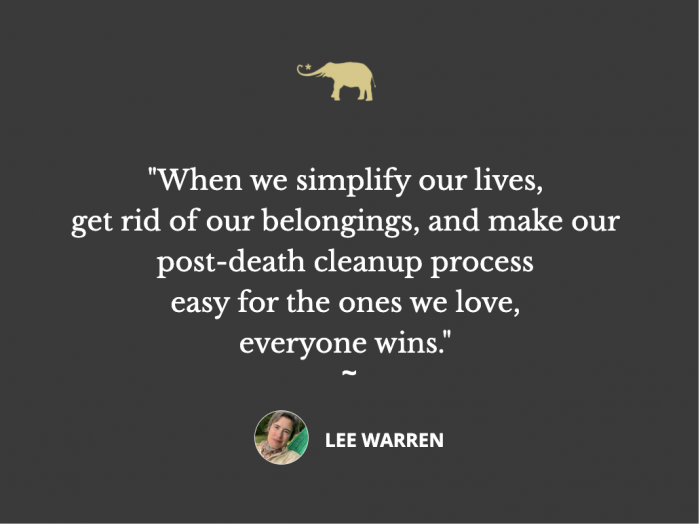~
“Fifty percent of life is letting go,” says the poet David Whyte.
We can see this mirrored in the natural world through the seasons, the moon cycles, and the life stages of all living things. For those of us engaged in personal transformation, we know that the internal cycles of life and death happen regularly. In fact, when we’re moving through life consciously we’re dying to our old notions, beliefs, feelings, and selves and opening to our emergent, expansive, and more integrated selves on the daily.
Yet our culture, due to many of its pathological notions, often gets stuck in messages of accumulation, limitations, and lack.
“He who dies with the most toys wins.”
That phrase got popular when I was in college back in the 80s. At that time in my life, I was part of a subculture of friends who valued their cars and trucks and boats and jet skis. Since that time, the meme has spun off into “whoever dies with the most fabric wins,” “the most cats,” or “the most tools.”
I have a real and hearty respect for people who know how to have fun—or who have a penchant for fabrics, cats, and tools that keep them engaged in life with so much passion. Even though I now live a more contemplative and monkish lifestyle than most, I can understand and relate to how easily stuff—like toys, and fabrics, and tools—can accumulate in every corner of life.
But this phrase, like most all death-related messages from our culture, conveys the idea that death doesn’t matter, that it doesn’t have an impact, that it’s just an afterthought, or that we needn’t think about it at all until it happens one day.
Based on my explorations of end-of-life issues, the opposite is true. The fewer worldly possessions we have when we die, the easier time we have of letting go and surrendering into the sacred journey. And more importantly, the bigger the blessing we leave for those around us.
Several years ago, I had the immense pleasure of supporting a dear friend in her dying process.
Kimchi, as she was lovingly known to her friends, decided from the moment of her diagnosis with breast cancer and six months to live, that she wanted a conscious and joyful death process. What she created over the next weeks was truly conscious and joyful, with the added benefit of being an educational opportunity for the entire community of people who knew her.
Kimchi was a much-loved human with a magical laugh, an extroverted spirit, boatloads of artistic talent, and dozens of close friends. Early on in her dying process, she signed over her car to a dear friend, willed her portion of a cooperative house to another friend, and added me to her bank accounts so that I could carry out her wishes for her remaining funds after her death.
The dissemination of her more personal items happened in these ways:
Kimchi was well known for her colorful, eccentric, and artful clothes, as well as beautiful handmade shoes, bags, and jewelry. When hundreds of folks arrived for the funeral, all of these beautiful items, as well as journals, books, and keepsakes, were laid out and every person there was encouraged to take what they wanted. We all watched in delight and wonder as most of Kimchi’s earthly belongings were scattered to the four directions like glitter on the wind to live another day with the people who loved her.
Later, among a smaller group of friends, Kimchi’s larger items, like her artwork, sculptures, furniture, and daily use items, were set up in a free silent auction format where each of her close ones, who still numbered a dozen or so, put our name on the things of hers that we most wanted. Friends later went through all the requests and made sure each of us got two or three items that we desired.
“Death is just a change of clothing,” says the Bhagavad Gita, a sacred and ancient text, reminding us that the death process is not the end and that there is more to come where we’re going. What a beautiful reminder to trust the process of life and of death.
I cherish the three pieces of art that hang on my walls from Kimchi’s free silent auction. As much because they came from a conscious and participatory dissemination process as that they represent her and her artful talent.
But what I cherish even more is the example. When we simplify our lives, get rid of our belongings, and make our post-death cleanup process easy for the ones we love, everyone wins.
I’ve actually seen this process play out differently in most cases. Instead of ease, playfulness, and joy, the process of cleaning up the financial and physical world possessions of a recently passed loved one is often experienced as an arduous and stressful burden. What’s more, it can sometimes drag on for months and even years. This encompassing immersion into the complexity of lawyers, money, and government can stop us from focusing on the sacred process of grief, transition, and closure.
I’ve taken away a great life lesson from this. I imagine myself at the end of life with just a handful of precious possessions. I delight in the idea that after I pass my dear ones will put out a little table at my funeral and take a few things to the thrift store. It’ll be fun. And easy. And ideally playful. And then, it will be done.
I expect my loved ones will be more available to celebrate my life and process my death without the struggle of dealing with my “stuff” hanging over their heads. My excitement about that vision helps me travel lightly through this life and bless the future with my present-day simplicity and minimalism.
Here are 9 ideas about how I embrace and practice that simplicity:
1. Limited Possessions
If I can keep my possessions to a minimum, then I don’t have to expend extra energy purging.
2. Six Month Rule
If I haven’t used something in six months, it becomes high on the list for the giveaway pile.
3. Don’t Buy New
Whenever possible I buy things that are used or recycled instead of new. That way, I can hold them lightly and pass them on when I’m ready to.
4. Replace, Don’t Add
For every new thing I bring in the house, I get rid of at least one other thing in the same category. For example, if I get three new sweaters, three old sweaters need to go.
5. Smaller Living Spaces
The tiny house movement is sweeping the world these days as people begin to experience the freedom and lightness of more simplicity. I live in a small cabin with a 250-square-foot living space and a 250-square-foot basement. My desire to live with spaciousness helps me limit the amount of material items I can bring into my home.
6. Discouraging Physical Gifts
I like to encourage and remind my friends not to give me presents for special occasions but instead to make a date with me for hiking, having tea, or some other fun friend activity. This cuts down on the physical items that come into my life.
7. Co-owning Big Items
I share a tractor with a bunch of other farmers. I’ve also been part of several car cooperatives where a half a dozen of us owned two cars together. That might not be reasonable or desirable for most people, but it is an option to keep down on the ownership of things.
8. Investing in High Quality
For possessions that I value, I try to invest in things that are high quality or meaningful. For example, all the art I own is made by local artist friends and the furniture I own tends to be high quality. I trust that the people who inherit these possessions will treasure them as I have.
9. Normalizing Giveaway Culture
Whenever it’s fun and accessible, I try to incorporate these things:
>> Clothing Swaps: I love to participate in swaps where new things are replacing old things. There’s always an additional special feeling knowing my new pants belonged to a dear friend.
>> Giveaway Party: White elephants don’t have to only be for holiday celebrations. Hosting a giveaway party can be a great way to pass on precious things to loved ones and learn about each other in the process.
>> Passing on Treasures: Sometimes I just have a sense that something is ready to move on from my life to someone else’s. I try to heed those inklings and move things on as much as possible.
As anyone who works in hospice knows, it’s an enormous gift to be with the dying. I’ve come to believe that the dying process is as much for the living as it is for the dying, especially if the dying have done some preparation in advance. Advanced preparation allows us to be more able to let go and be present. And when we are more able to be present with the process of dying, the gift to everyone involved increases exponentially.
Preparing internally and externally for the eventuality of our deaths is a life-long practice. The invitation inherent in these practices is to contemplate the concepts of impermanence and mystery. Impermanence reminds us to savor the moment and mystery reminds us that we’re not in control.
While collecting physical objects, like toys and fabrics, may indeed be fun and temporarily satisfying, I suggest that getting in touch with the sacredness of existence, being present in our process of transition, and making it easy on our loved ones is a much more worthy goal.
~
AUTHOR: LEE WARREN
IMAGE: ELEMENT


Most excellent article and a much need to read for many! Thank you!
Reply